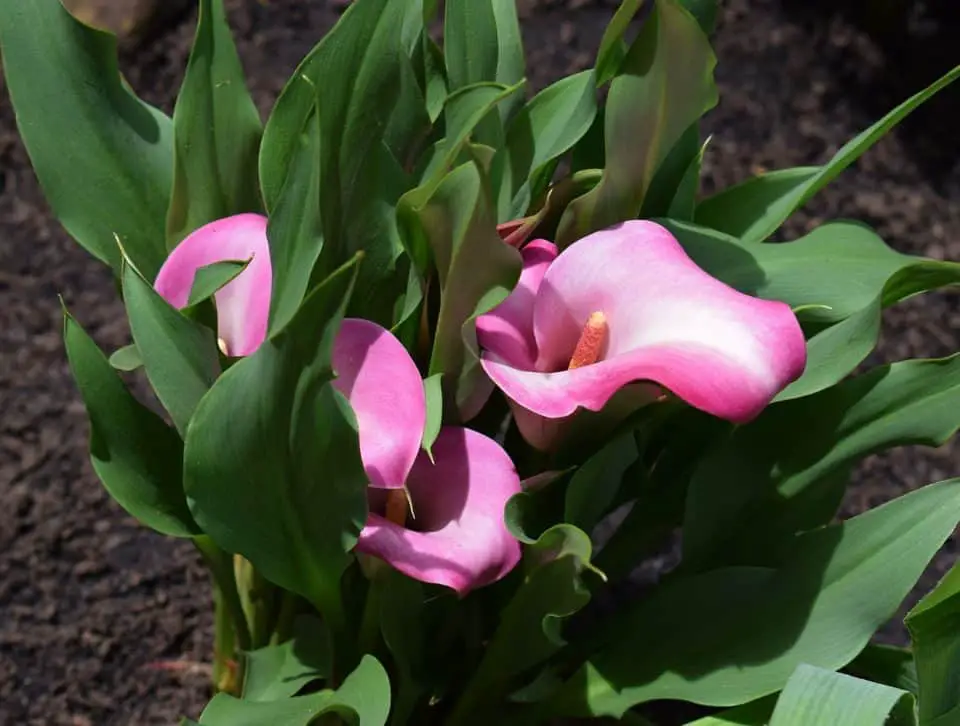Some links in the post are affiliate links and I get a commission from purchases made through some links found in the post.
The calla lily is a vibrant plant native to the southern parts of Africa. Compared to most plants, it is relatively easy to grow and should be a breeze to care for, even for beginners.
Even so, some conditions may not be favorable to the plant’s growth, and you may notice some adverse changes in its growth pattern.
These include yellowing and curling leaves, pest attacks, limp stems, and more.
Luckily, if you can fix the problem as soon as you spot it, you will have a much better chance of saving the plant.
This guide covers the most common issues encountered by gardeners, what they indicate and how you can deal with them effectively to revive your dying calla lily.
How do you Revive a Dying Calla Lily?
 Often, when people notice that their plants are not doing so well, there’s a tendency to look for an easy fix.
Often, when people notice that their plants are not doing so well, there’s a tendency to look for an easy fix.
For example, if you notice your plant looks a bit shrunk and has limp stems and leaves, you might think that watering it can save the plant.
However, without correctly diagnosing the problem, you can end up aggravating the causative factor, making the problem even worse.
To help you deal with the problem once and for all and avoid its reoccurrence, you have to address the specific cause as we will cover below.
The problems below will help you to resolve why your calla lily is dying and therefore what is the best way to treat it and revive it from there.
You may also like: how do you care for a peace lily in the winter.
Why are my Calla Lily Leaves Curling?
The first thing to note is that the curling of leaves is not typical in calla lilies, and you’re right to express concerns over the change.
In most cases, the curling should point to one of the causes below:
Underwatering
Your plant cannot do well if the soil is not moist. Without this water content, it becomes much more challenging for the roots to absorb nutrients from the soil.
Additionally, the leaves cannot replenish the water they lose to the environment via transpiration.
In the end, the leaves start curling up, indicating that they need more water.
You need to look into if you’ve been underwatering your plant. Typically, you should water the plant when the two top inches of the soil are dry.
You might find that watering is necessary every other day in hot areas, and you need to keep up with the water requirements.
If this proves hard, you can always buy a moisture gauge to help you strike a balance between overwatering and underwatering the plant. Ensure that you leave the soil moist but not soggy.
Bad Water Quality
If you’ve recently moved the plant indoors and it’s started to curl its leaves, your water quality could be the problem.
Often, plants can make do with tap water, which is cheaper and more convenient for the gardener.
However, depending on where you live, the water quality from the tap may not be the most ideal, and you may want to consider other sources of water.
Avoid sources with chemicals such as chlorine and an overload of minerals as these can shock the plant.
If you want to save money, try and use a water filter or allow the water to sit for a while before using it to feed the plant.
Poor Lighting
Calla lilies are naturally drawn to light and will do well in the full sun and partial shade.
Lack of access to bright and direct light can lead to them becoming unhealthy over time, which will show in the curling of the leaves.
If the plant is in a low-light environment, you will need to move it to a better-lit area. Ideally, the plant should receive full sun for several hours each day.
However, if you do not have this kind of access, you can leave them in a location where they can get some partial sun. Supplementing the sun with indirect bright light is also fine.
Lack of Nutrients
When potting your plant, you should ensure that the potting mix has sufficient nutrients. Try this easy to use fertilizer to give your plant that little boost.
As much as calla lilies are not big on nutrients, they still need a boost to help them grow well. The plant will do even better if you use a well-draining and well-aerated mix.
Over time, also consider boosting them with a feed during the active growing seasons.
If you notice that the plant’s leaves are curling, it could be under nutrient stress, and some input may be necessary.
Please be careful with how much fertilizer you give the plant. Using too much fertilizer can trigger worse problems than curling.
Low Temperatures
The calla lily is a tropical plant, and it thus does better in warm environments. If you live in a cold area, you may notice that the plant is not doing so well.
You can change this by turning up the heat. During the day, ensure that the temperatures do not fall under 60 degrees Fahrenheit and at night, ensure they do not dip below 55 degrees Fahrenheit.
Higher temperatures will not be a problem, and as long as you water the plant to keep up with the evaporation rates, the plant should be fine.
However, if you allow the temperatures to fall below the given minimum points, you will notice curling, among other issues.
Please note that this can also happen if the plant is near a window or door where drafts can get to it.
Also, plants growing outside are more likely to suffer such adverse reactions because they are not in a controlled environment. It might be time to move the lily indoors.
Why are my Calla Lily Leaves Turning Black?
Can you imagine seeing your calla lily leaves develop a black hue? Well, this can happen due to:
Low Humidity
 Calla lilies do best in warm environments that mimic their native growing conditions. As such, you need to keep an eye on the temperatures and ensure they do not fall below 50 degrees Fahrenheit.
Calla lilies do best in warm environments that mimic their native growing conditions. As such, you need to keep an eye on the temperatures and ensure they do not fall below 50 degrees Fahrenheit.
In very hot and dry regions, you can try misting the plant to account for humidity.
It’s often much easier to place a pebble tray under the pot as this creates a humid environment, triggering the plant to grow more.
Another trick is to surround the plant with others, and together, the plants will create a humid environment.
However, you should only do this if the other plants will also benefit from such an environment.
Always have an eye on the temperature; else, the calla lily plant can go dormant and show signs of dying which may mean you need to revive it.
Other causes of blackening leaves include:
- Underwatering
- Excess salts in the soil from using too much fertilizer or tap water laden with chemicals and minerals
You may also like: Can a peace lily survive outdoors
Why is my Calla Lily Turning Brown?
Your calla lily can turn brown due to:
Overwatering
You need to be aware of how much water your plant needs relative to its environment.
Often, people water their plants without checking if the soil is dry enough to hold the water.
As such, they end up drowning the roots, causing root damage. Unfortunately, this can not only slow down the plant’s growth, but it can also kill it.
As the damage starts, you might notice browning leaf tips, which you might confuse with underwatering (remember the curling leaves?)
Assess how much water you have been giving the plant and check the state of the soil.
Additionally, tip the plant over and remove it from the pot to check if there’s any root damage.
If the roots are okay, leave the plant be and give it time to recover from the overwatering.
However, if the roots appear damaged, you will need to cut out the damaged parts and repot the plant in a fresh potting mix.
In the future, you will need to water the plant only when the top two inches of the soil are dry. If this proves hard, consider using a moisture gauge to help you strike the right balance.
If you need help watering your plant, try using this automatic drip irrigation kit.
Sun Damage
As much as calla lilies like full sun, you may live in an area that is particularly too hot for the plant’s leaves to withstand.
If you often leave the plant in the sun for long hours, you may notice that they may develop some brown tips.
It can happen during sweltering days. Place the plant in a location where it can get bright light access without this direct contact.
Also, trim the affected leaves, enabling the plant to focus on developing fresh leaves.
If your plant is struggling due to light, trying using this to help regulate the lighting.
Cold Weather
Calla lilies prefer to be in warm environments, and when left out in the cold, they can develop frost damage.
If the temperature falls below 50 degrees Fahrenheit, try and adjust it to be warmer. Also, move outdoor plants to the indoors when the temperatures take a turn for the worse.
It helps to make sure that the plant parts are not touching cold surfaces such as windows, which can also trigger the damage.
Remove the damaged parts and allow the plant to recover and develop fresh foliage.
Other causes of browning leaves include:
- Underwatering the plant
- Overfeeding the plant with fertilizer
If you are enjoying this article, check out our article on why is your anthurium flower bud turning brown.
Why are my Calla Lily Leaves Turning Yellow?
Here’s the first thing you should note- gradual yellowing is typical in calla lilies.
As the leaves age and start to die, they turn yellow. It’s a natural process that paves the way for new foliage.
However, fast and spreading yellowing when the plant was previously fine can indicate that all is not well with the plant. Causes include:
Root Rot
If you’ve been overwatering your plant, you’ve likely drowned the roots long enough for them to suffer damage.
These plants do not do well when their roots are constantly in water, and the roots gradually start to rot.
Not only does this affect the plant’s ability to draw nutrients from the soil, but it also triggers the death of the plant.
Additionally, the plant becomes more susceptible to pests and diseases, affecting its ability to fight off attacks.
The yellowing on the leaves of your calla lily is the first sign, and if you notice that the leaves are dying back without triggering new foliage, you likely have a problem in your hands and you may need to help revive it.
Other than overwatering, the root rot can also be due to poor drainage. Check that the pot has sufficient drainage and that none of the holes are blocked.
When using a pebble tray underneath, make sure that the pot rests on the pebbles and not the water.
Also, you need to check the quality of the potting mix. If it’s not well-draining, you need to change it to ensure that the mix allows water to flow out of the pot.
Calla lily soft rot treatment
You need to tip the plant over and assess the roots. If you catch the problem early on, you have a good chance of dealing with the damage and ensuring the plant continues to thrive.
If the plant exhibits white and fibrous roots, the plant is fine. All you need to do is change your watering pattern, adjust the potting mix or adjust the pot’s drainage as required
However, if the roots appear slimy, black, or brown and have an unpleasant odor, it indicates that root rot has occurred.
If you catch it early, the sliminess will only be present in a small section.
However, if it has spread over the whole root, it’s too late, and there’s nothing you can do to save the plant. In this case, you need to discard it in a place where it cannot infect other plants.
Suppose the root rot is mild or moderate; you need to cut off the damaged parts, wash the root and repot the plant in a new potting mix.
Make sure the pot is well-draining and that the mix is well-aerated. Once the plant adjusts to its new home, resume watering and ensure you do not overwater it.
Other possible causes of yellowing include:
- Too much fertilizer in the soil
- Transplant shock
- Exposure to the cold
Common Calla Lily Pests and Diseases
 Once your plant starts showing signs of dying, you have to act fast as it’s more susceptible to pests and diseases in this state.
Once your plant starts showing signs of dying, you have to act fast as it’s more susceptible to pests and diseases in this state.
Likely attacks include botrytis, powdery mildew, viruses, and bacterial soft rot in the disease category.
As for pests, you need to watch out for aphids, slugs, spider mites, whiteflies, and thrips.
Luckily, these pests rarely attack plants that are healthy and well maintained.
The best way to avoid such attacks is by ensuring that you give your plant the proper care it deserves. When you spot something amiss, act fast to prevent its spread.
For the most part, dealing with a calla lily should come easy, and you should not face any troubles.
Ensure that you mimic a tropical environment and avoid exposing the plant to low light, low temperatures, and drafts.
Also, watch how much fertilizer you give the plant and how often you water it. Moderation should be your guide as you work to revive your dying calla lily plant.
Before you go, here are some more related articles I encourage you to read below to help solve more of your gardening issues:
Why are my peace lily flowers turning brown
Happy Gardening!

